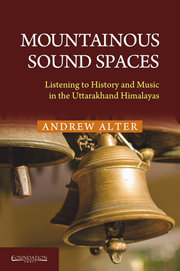Book contents
- Frontmatter
- Contents
- List of Figures
- List of Tables and Musical Examples
- Preface
- Acknowledgements
- Introduction
- 1 Echoes of Colonialism: Bagpipes in the Himalayas
- 2 Echoes of a Royal Heritage: Vestiges of Naubat
- 3 Possession and Performance: Sounding Out the Epic Worlds of Heroes and Gods
- 4 Worlds of Sound: Revisiting the Parameters of Oral Tradition
- 5 Flutes, Sprites and Mountainous Geographies
- 6 Drum Strokes, Syllables and Rhythmic Patterns
- 7 The Significance of Tantric Sects for Drum Practice in the Central Himalayas
- 8 Playing History: Sounding Out the Epic Worlds of Heroes and Gods
- 9 The Legacy of Garhwali Cassettes: Remembering the Pre-digital Age of Music Commodification
- Epilogue: Listening to an Uttarakhandi Himalayan Space
- Bibliography
- Index
6 - Drum Strokes, Syllables and Rhythmic Patterns
Published online by Cambridge University Press: 05 October 2014
- Frontmatter
- Contents
- List of Figures
- List of Tables and Musical Examples
- Preface
- Acknowledgements
- Introduction
- 1 Echoes of Colonialism: Bagpipes in the Himalayas
- 2 Echoes of a Royal Heritage: Vestiges of Naubat
- 3 Possession and Performance: Sounding Out the Epic Worlds of Heroes and Gods
- 4 Worlds of Sound: Revisiting the Parameters of Oral Tradition
- 5 Flutes, Sprites and Mountainous Geographies
- 6 Drum Strokes, Syllables and Rhythmic Patterns
- 7 The Significance of Tantric Sects for Drum Practice in the Central Himalayas
- 8 Playing History: Sounding Out the Epic Worlds of Heroes and Gods
- 9 The Legacy of Garhwali Cassettes: Remembering the Pre-digital Age of Music Commodification
- Epilogue: Listening to an Uttarakhandi Himalayan Space
- Bibliography
- Index
Summary
The previous three chapters examined the epic repertoire of Uttarakhand in order to provide details of indoor musical practice. In addition, the stories that were discussed provided texts and themes that could be fruitfully mined for perspectives on caste hierarchy and ideologies associated with instruments. The huṙkī drum and the voice of the performer were the primary components of the aural phenomenon of story singing. An overarching framework for the discussion of the stories, as well as the creative practices undertaken in their construction, was appropriately provided by theories of oral tradition.
In contrast, this chapter shifts focus away from the huṙkī, and moves to a consideration of outdoor drums; namely the ḍhol and the damauṅ. Nonetheless, the discussion remains concerned with practices of oral tradition, particularly related to how ‘drum knowledge’ is vocalized in particular ways. Consequently, I seek to focus on the way drummers use syllabic recitation as a means to signify repertoire items and thereby oralize a practice of drumming. The implications of this oralization are considered within the broader context of drumming in other areas of South Asian practice.
I have always been somewhat uncomfortable in describing and notating the drum syllables used by village drummers in Garhwal. On the one hand, when I became aware that some drummers used syllables to describe repertoire, it appeared logical to use these syllables in some way to notate and visually represent the drum patterns that I was listening to. On the other hand – though syllables represented an emic approach to drum stroke conceptualization – they never quite provided the direct link between sound and physical action that I was looking and listening for. Identifying particular vocalized syllables in relation to specific striking points on the drumheads was always more problematic than I had imagined it should be.
- Type
- Chapter
- Information
- Mountainous Sound SpacesListening to History and Music in the Uttarakhand Himalayas, pp. 80 - 96Publisher: Foundation BooksPrint publication year: 2014

